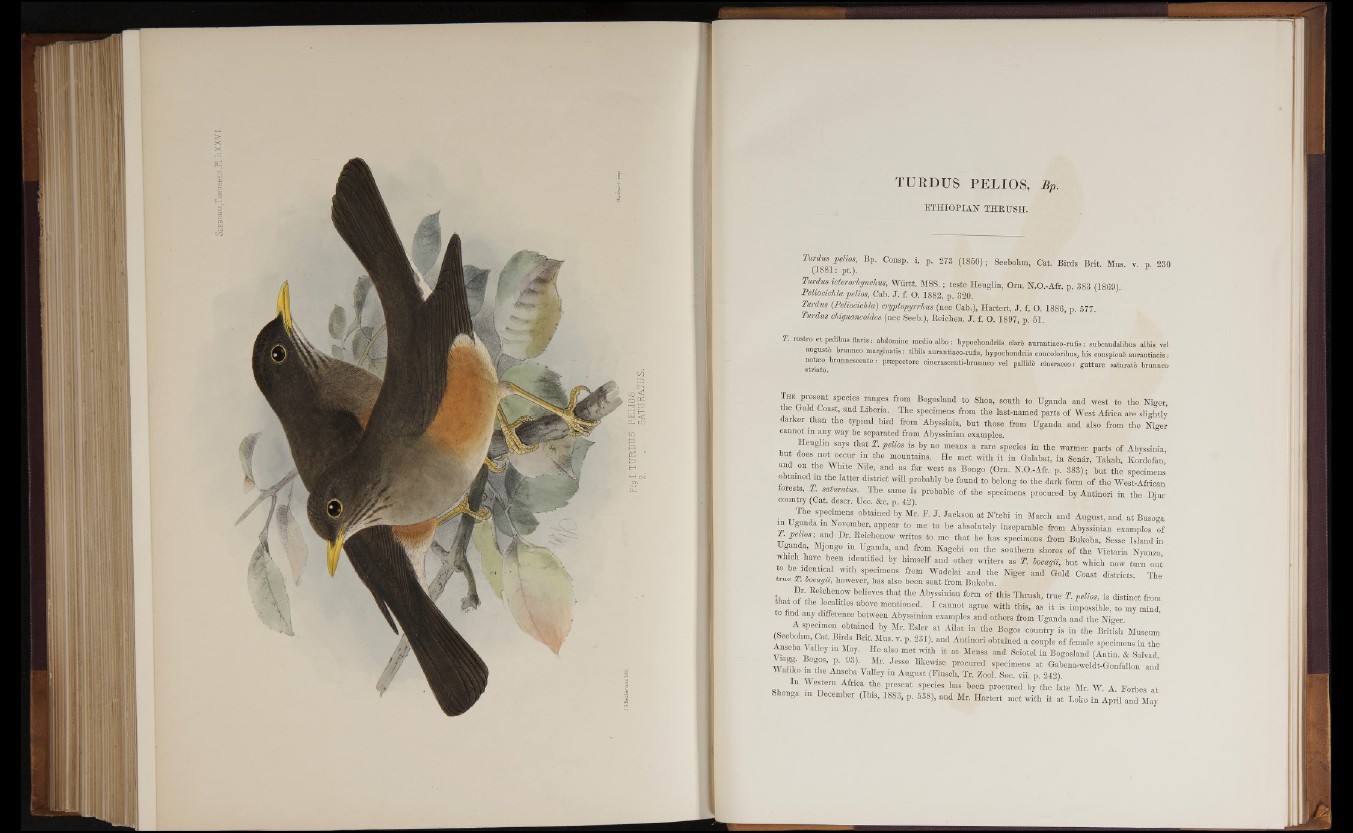
1 H B— EELIOS
■ 2. SATI1.RATUS TURDUS PELIOS, Bp.
ETHIOPIAN THRUSH.
W W m m Bp' C°nSp- 11 P' 278 (185° ) ; Seebohm, Oat.'Birds (,lo81: pt.). Brit. Mus. v. p. 230
Turdus icterorhynchus, Wiirtt. MSS.; teste Heuglin, Orn. N.O.-Afr. p. 383 (I860)..
Pelioeichla pelios, Cab. J. f. O. 1882, p. 320.’
Turdus (Peliocichlg) cryptopyrrhus (nee Cab.), Hartert, J. f. O. 1886, p. 577.
Twdus chigumcoides (nee Seeb.), Beichen. J. f. O ,1897, p. 51.
T. rostro et pedibus Ban s: abdomine medio albo : hypoclondriis d a r t aurantiaco-rnfls: subcaudalibus albis vel
august!) brunneo marginatis: tibiis aurantiaeo-rufis, bypoeiondriis eoncoloribus, his oonspicue aurantiacis ■
notgeo brunnescente: prapectore cinerascenti-brunneo vel palHde cmeraceo : gutture saturate brunneo
crwatA
the Gold Coast, and Liberia. The specimens from tbe last-named parte of West Africa are slightly
darker than the typical bird from Abyssinia, but those from Uganda and also from the Niger
cannot m any way be separated from Abyssinian examples.
Heuglm says that T. pelios is by no means a rare species in the warmer parts of Abyssinia
but does not occur in the mountains, He met with it in Galabat, in Senar, Takah, Kordofan
and on the White Nile, and as far west as Bongo (Om. N.O.-Afr. p. 383); but the specimen^
0 amed in the latter district will probably be found to belong to the dark form of tbe West-African
orests, T. saturates. The same is probable of the specimens procured by Antinori in H ie Diur
country (Gat. descr. Ucf.O&o. p. 42). S B n R T J
The specimens obtained by Mr. P. J. Jackson at N’tebi in March and August, and at Busoga
1 g“ da m N°™mber, appear to me to be absolutely inseparable from Abyssinian examples of
rr' B H H ' Eelellenow B | to me that he has specimens from Bukoba, Sesse Island in
Uganda, Mjongo m Uganda, and from Kagehi on the southern shores of the Victoria Nyanza
which have been identified by himself and other writers as T. tocagii, but which now turn out!
to be identical with specimens from Wadelai and tbe Niger and Gold Coast districts. Tbe
true J.. oocagu, however, has also been sent from Bukoba.
that Br' Bei°h™°w beUeves that the Abyssinian form of this Thrush, true T. pelios, is distinct from
that of the localities above mentioned. I cannot agree with this, as it is impossible, to my mind
to find any difference between Abyssinian- examples and others from Uganda and the Niger.
■ B H H B B Mr' EsIer at H “ the B°g°s 00UIltry is I the M l Museum ’ (Seebohm, Cat. Birds Bnt. Mus. v. p. 231), and Antinori obtained a couple of female specimens in the
Anseba Valley in May. He also met with it at Mensa and Sciotel in Bogosland (Antin. & Salvad
WaH k o iuT e AP' IR 9 H B B pr00ured sPecimeM at Gabena-weldt-Gonfallon and
m tbe Anseba VaUey m August (Finsch, Tr. Zool. Soc. vii. p. 242).
in Western Africa the present species has . been procured by the late Mr. W. A Forbes at
Shonga. m December (Ibis, 1883, p. 538), and Mr. Hartert met with it at Loko in April and May